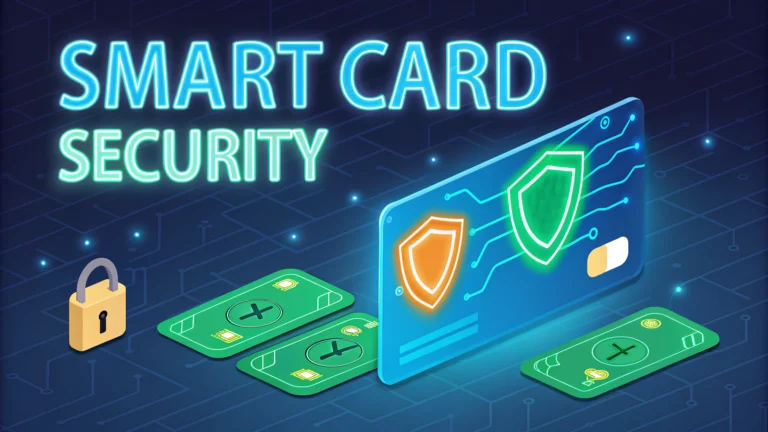Smart card security testing helps organizations identify and fix vulnerabilities before attackers can exploit them.
Security professionals conduct penetration testing on smart cards to evaluate physical security, cryptographic implementations, and communication protocols.
This guide covers essential smart card penetration testing methods, tools, and best practices used by security experts.
Physical Security Testing
Side-channel attacks analyze power consumption patterns during cryptographic operations to extract secret keys.
Fault injection techniques use voltage glitching, electromagnetic pulses, or laser attacks to induce errors and bypass security controls.
- Microprobing equipment to access internal circuits
- Chemical etching to remove protective layers
- X-ray imaging to inspect internal components
- Thermal analysis during operations
Logical Security Assessment
Protocol analysis tools examine the communication between cards and readers for vulnerabilities.
- Smart card readers: ACR38U, SCM SCL011
- Protocol analyzers: Proxmark3, ChipWhisperer
- Software tools: GlobalPlatform, GPShell
Cryptographic Testing
Testing cryptographic implementations requires specialized equipment and expertise.
- Key length verification
- Random number generator quality
- Authentication mechanism strength
- Encryption algorithm implementation
Common Attack Vectors
| Attack Type | Description |
|---|---|
| Man-in-the-middle | Intercepting communication between card and reader |
| Replay attacks | Recording and replaying valid transactions |
| Buffer overflows | Sending malformed APDU commands |
| Timing attacks | Analyzing response times to guess secrets |
Testing Tools and Equipment
Professional testing requires specialized hardware and software tools.
- Hardware: Oscilloscopes, logic analyzers, card readers
- Software: CardPeek, OWASP JCAF, SmartCard-HSM
- Analysis: WireShark, Riscure Inspector
Security Controls
Implement these controls to strengthen smart card security:
- Secure key storage and management
- Strong authentication mechanisms
- Encrypted communication channels
- Access control policies
- Regular security updates
Next Steps for Smart Card Security
Regular security assessments help maintain the integrity of smart card systems.
- Schedule periodic penetration tests
- Keep testing tools updated
- Document findings and remediation steps
- Train security teams on new attack methods
Contact certified smart card security labs like Brightsight or UL for professional testing services.
Documentation and Reporting
Thorough documentation helps track vulnerabilities and remediation progress.
- Detailed test methodologies
- Found vulnerabilities and severity levels
- Proof of concept examples
- Mitigation recommendations
Compliance and Certification
Smart card security testing must align with industry standards and regulations.
- EMV certification requirements
- Common Criteria evaluations
- PCI DSS compliance
- FIPS 140-2 validation
Risk Management
Risk Assessment
- Asset identification
- Threat modeling
- Vulnerability assessment
- Impact analysis
Risk Mitigation
- Security control implementation
- Incident response planning
- Business continuity measures
Securing Smart Card Infrastructure
A comprehensive security approach ensures long-term smart card system protection.
- Regular system audits
- Continuous monitoring
- Security awareness training
- Vendor security assessments
- Incident response readiness
Building a Resilient Smart Card Ecosystem
Organizations must maintain vigilance in protecting smart card systems against evolving threats.
- Establish security testing programs
- Implement defense-in-depth strategies
- Stay informed about new vulnerabilities
- Foster security-aware culture
- Partner with security experts
FAQs
- What is smart card penetration testing?
Smart card penetration testing is a systematic process of evaluating the security of smart card systems by identifying and exploiting vulnerabilities in the card’s hardware, software, communication protocols, and cryptographic implementations. - What are the common attack vectors in smart card security testing?
The main attack vectors include side-channel attacks (power analysis, electromagnetic analysis), fault injection attacks, protocol attacks, cryptographic attacks, and physical tampering attempts. - How does power analysis attack work in smart card testing?
Power analysis attacks monitor the power consumption patterns of a smart card during cryptographic operations to extract secret keys. Simple Power Analysis (SPA) examines direct power traces, while Differential Power Analysis (DPA) uses statistical methods on multiple traces. - What tools are commonly used in smart card penetration testing?
Common tools include ChipWhisperer for side-channel analysis, smart card readers like ACR38U, protocol analyzers like Scriptor, and specialized software such as GlobalPlatform Pro and GPShell. - What is fault injection testing in smart card security?
Fault injection testing involves deliberately introducing errors into the smart card’s operation through voltage glitching, clock manipulation, or electromagnetic pulses to bypass security controls or corrupt data processing. - How can EMV payment cards be tested for vulnerabilities?
EMV cards can be tested through protocol analysis of the EMV transaction flow, verification of cryptographic implementations, testing of PIN verification methods, and checking for known vulnerabilities in specific EMV implementations. - What security measures do smart cards implement against physical attacks?
Smart cards employ protective meshes, environmental sensors, memory encryption, secure memory management, tamper-responsive circuitry, and active shields to prevent physical tampering and unauthorized access. - How are cryptographic implementations tested in smart cards?
Cryptographic testing involves validating key generation processes, examining random number generators, testing encryption/decryption operations, and verifying the implementation of cryptographic protocols like RSA and AES. - What are relay attacks in smart card testing?
Relay attacks test for vulnerabilities where an attacker can intercept and forward communication between a legitimate card and reader, bypassing proximity requirements and security checks. - How is application-level security tested on smart cards?
Application-level testing includes analyzing command sets, testing access control mechanisms, validating secure messaging implementations, and checking for vulnerabilities in application data management.







